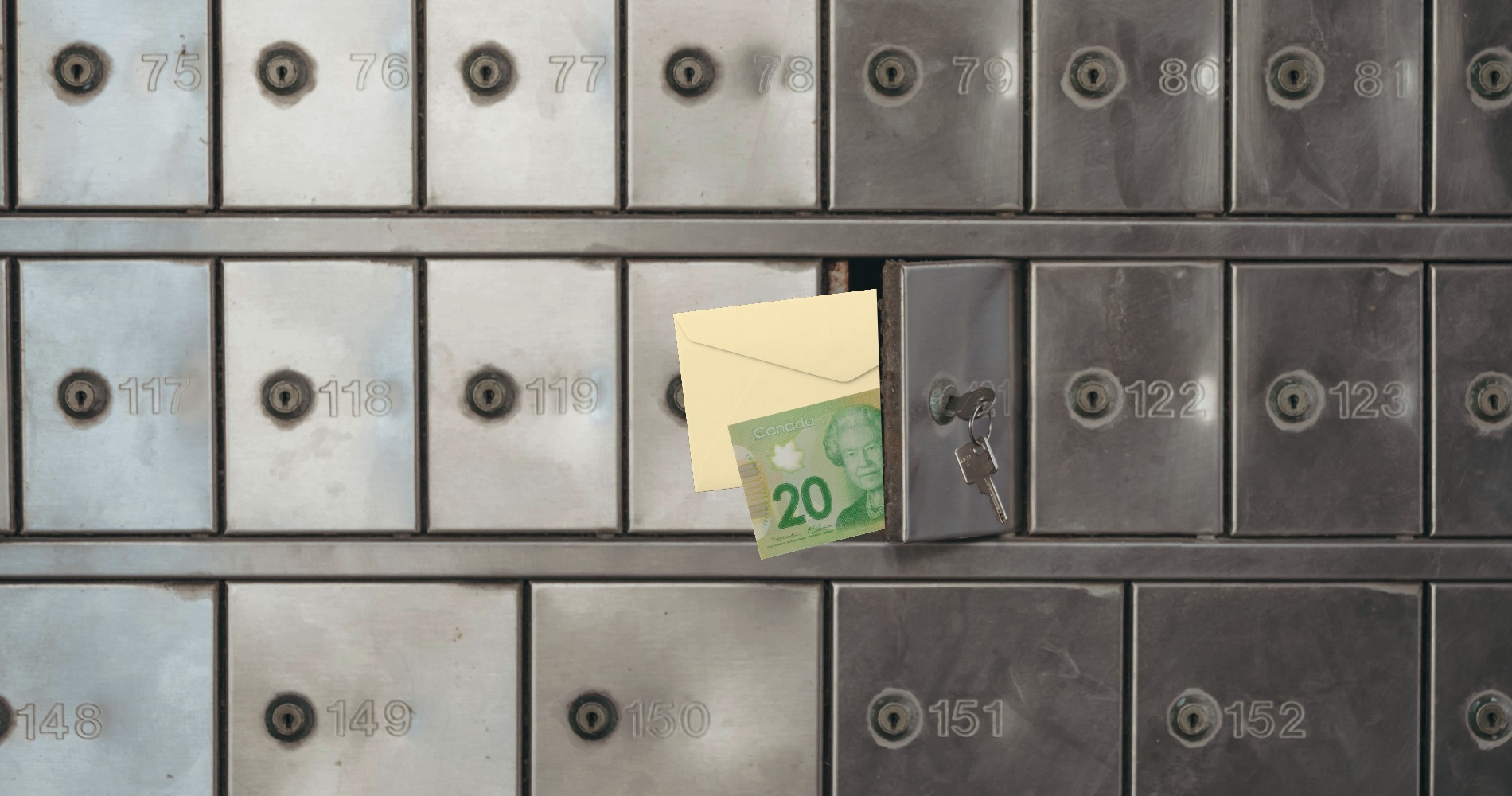Among the many proposals to transform Canada Post, one stands out: postal banking. It’s a program that could contribute to solving multiple policy problems at once—help support our postal service with stable revenue, boost financial inclusion and enhance public services, and, unlike conventional banks that put profit first, create accessible public interest banking services.
Postal services are a cornerstone of financial inclusion across the world, offering low-cost financial services to traditionally underserved populations that are not lucrative enough customers for big banks to bother with.
Millions of people in Canada are under-served by the banking industry, with many forced to rely on exploitative pay-day loans and cheque cashing services. In the many communities that have become banking deserts after bank branch closures, post offices are well placed to fill the gap.
Postal banking isn’t just for the underserved though. Canada’s banking industry is one of the least competitive in the world, dominated by a handful of big banks, causing bank customers to pay billions each year in excess banking fees.
Most people are tired of being price gouged by their bank, so there is a widespread appetite for change. A public sector postal bank could inject some much needed competition into the sector, providing an affordable and trustworthy alternative to the banking oligopoly.
A Canadian postal bank could also fill a bigger role as a public sector investor. It could make strategic investments in areas neglected by corporate banks. France’s Banque Postale, for example, has become the country’s leading provider of banking services and credit to co-operatives, social housing providers, hospitals, and non-profits.
When we run the numbers using reasonable assumptions based on domestic financial institutions and comparable postal banks, we see that a moderately successful bank could have stabilized the finances of Canada Post—while a highly successful one would have dramatically boosted the fortunes of the postal service. In the most optimistic outcome, a postal bank provides enough net revenue to eliminate the group’s deficit and make needed investments to diversify the group’s activities even further.
What if we created a postal bank ten years ago?
Let’s conduct a thought experiment in which the Canadian government took recommendations to expand into postal financial services seriously and created a Canada Post Bank (CPB) a decade ago. This bank, in our scenario, was given the tools and support it needed to succeed, including a full chartered bank license, so it can offer a full range of financial services.
We will check in on our hypothetical postal bank 10 years later in 2024-25, across three different scenarios based on the level of success achieved. These scenarios are built around the share of customer deposits at Canadian banks and credit unions that the CPB was able to gain:
- Low success: 1.5 per cent of all Canadian deposits, valued at $57 billion.
- Moderate success: 2.5 per cent of all Canadian deposits, valued at about $94 billion.
- High success: 3.5 per cent of customer deposits, valued at $132 billion.
The bulk of the CPB’s business would be leveraging its nation-wide network to provide affordable customer-facing retail banking aimed at individuals and small to medium sized businesses. While the CPB would seek to make a profit, it would also have a public interest mandate to provide affordable financial services, especially to underserved people and communities.
Throughout the analysis, we use large credit unions as a point of reference for our postal bank. Both the user-base and services provided overlap, mostly offering affordable retail banking services to small customers, rather than catering to large corporations and the wealthy.
How large could a Canadian postal bank grow?
We have estimated the potential size of the CPB based on the amount of customer deposits. To determine the bank’s number of customers, we assume a ratio similar to large credit unions of about $38,000 in deposits per customer. Depending on its degree of success, the CPB could have from 1.5 to 3.4 million customers by now.
Based on survey research commissioned by the Department of Public Services and Procurement, it seems like a plausible number of customers. According to the survey, an estimated 19 per cent of Canadian adults said they would be likely to use postal banking services if it were an option. There were 31 million adults in the country in 2022, suggesting a potential customer pool of just under six million people.
We estimate the size of the bank’s assets using the value of customer deposits. From a bank’s perspective, deposits are liabilities that it owes to customers and can be used to fund the creation or purchase of assets like loans or mortgages. Deposits tend to be worth about 50 per cent of total funding for mid-sized Canadian banks. Using that ratio yields a postal bank owning assets valued at $113 to $264 billion.
How much revenue could a Canadian postal bank make?
Through four main pillars of revenue—net interest income, wealth management, other non-interest income, and payments—our hypothetical postal bank could be making between $1.9 to $4.4 billion in revenue, had it started a decade ago.
Net interest income
Net interest income is revenue that financial institutions make by charging interest on debt. It is calculated by subtracting the interest payments a bank pays out—for example, payments to customers for their deposits—from the interest income a bank collects on interest-bearing assets like loans, mortgages or government bonds.
Assuming an average net rate of return of 1.6 per cent, the CPB could have made from $979 million to $2.3 billion in net interest income. This is a conservative figure and could be higher in practice. Quebec’s federation of credit unions, Desjardins, regularly reports a net interest margin of over 2.5 per cent.
Wealth management
Managing wealth for customers is an important source of bank revenue. This includes fees and commissions for things like investment advice or managing customers’ retirement savings and investment portfolios. Assuming that the CPB makes an average return of 0.6 per cent of assets under administration, it could be making from $414 to $965 million in wealth management revenue.
Other non-interest income (mostly service fees)
This broad group contains mostly service fees (other than those from wealth management or bank card use) such as account fees, overdraft charges, or currency exchange fees. It also includes a small bucket of miscellaneous income or losses that banks normally incur related to their investment and risk management activities. Assuming the CPB doesn’t hit customers as hard on fees as other banks do, and would have a lower fee structure comparable to the largest credit unions (about $270 per user), we estimate that it could be getting $395 million to $922 million in other non-interest revenue.
Payments
Finally, most banks report fee revenue from bank cards and credit cards separately from other fee revenue. This category includes revenue made by charging annual and transaction fees on debit and credit cards, as well as fees charged to businesses that accept payments with credit cards. Canada’s big banks made about $90 per customer in payments revenue in 2024-2025. Using a lower rate of $70 per customer, we have estimated that the CPB could be receiving an additional $102 to $239 million in payments revenue.
Total revenue
These sources add up to between $1.9 to $4.4 billion of total revenue from the low to high scenarios. The bank would have contributed between 17 to 32 per cent of the postal group’s total revenues. These totals are conservative, since there are more ways a bank can make money.
How does the postal bank impact Canada Post’s bottom line?
One needs to spend money to make money. Four billion dollars of revenue would not do the company any good if accompanied by five billion dollars in new spending. To gauge the impact of the bank on the Canada Post Group’s overall finances, we also need to know the bank’s operating costs.
If we assume that the CPB had a cost-to-income ratio of 68 per cent (in line with mid-sized domestic banks, large credit unions, and other postal banks), that leaves 32 per cent of revenue after subtracting operating costs.
Now we can imagine the impact of the bank on the group’s finances, which posted an annual loss of $987 million in 2024-25. In the following table, we can see the profit or loss for the group with and without the postal bank in each scenario.
This means that the CPB needed to have at least 2.5 per cent of Canadian customer deposits ($97 billion) for its profits to allow the entire postal service to eliminate its deficit. It would help to stabilize the company’s financial position and could lead to a healthy surplus if core revenues improve even modestly in the years to follow.
If the CPB met our most optimistic expectations, it would dramatically improve the financial picture for Canada Post. A bank gaining 3.5 per cent of customer deposits ($132 billion) would provide ample revenue to offset the core operating deficit and then make additional investments to further enhance and diversify the services of the entire group.
Even the best-case scenario is quite realistic
Despite sounding very impressive, a postal bank owning over $260 billion in assets and booking four billion dollars in revenue would be quite reasonable. In the table below, we compare our hypothetical postal bank’s most optimistic outcome to other successful postal banks.
Slotted into Canada’s banking landscape, the CPB appears even more modest. The common assertion that a Canadian postal bank could never succeed because it is impossible to compete with the big banks that dominate the sector is plainly untrue.
For a postal bank to be successful enough to transform Canada Post’s future, we only need to reach a bank which is still relatively small in stature and not nearly as profitable as the banking giants. It could charge lower fees, provide better service than the big five and still turn a profit.
The CPB’s pre-tax profits in the best outcome were only about a third as much as either the National Bank or Desjardins made, yet that was more than enough to secure the future of Canada Post. The CPB’s pre-tax profit margin of 32 per cent was exactly the average among our sample of banks and credit unions.
The time to create a postal bank is now
Unfortunately, the government did not create a postal bank when it ought to have done so. The second best time to start a postal bank is right now. Getting a postal bank started would no doubt take considerable public investment and support, but it would be a genuine nation-building project.
While a postal bank might not be profitable immediately, it might not take long. Portugal’s BancoCTT was fully operational in 2016 and breaking even by the third quarter of 2019. In Austria, the newly established Bank99 is already making a positive contribution to the postal service’s finances just a few years after being founded in 2020.
Arrangements with existing financial institutions are a proven method of ramping up toward full postal banking. Partnerships being made today, for example postal savings accounts through KOHO, could both provide an immediate revenue boost and serve as important first steps to building up toward genuine postal banking. Postal banking is proven and the potential in Canada is undeniable, what is missing is the political imagination and will to start making it a reality.


